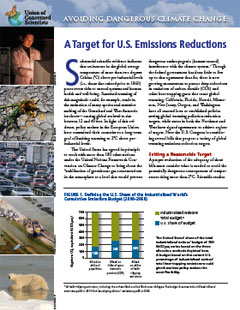Substantial scientific evidence indicates that an increase in the global average temperature of more than two degrees Celsius (°C) above pre-industrial levels (i.e., those that existed prior to 1860) poses severe risks to natural systems and human health and well-being. Sustained warming of this magnitude could, for example, result in the extinction of many species and extensive melting of the Greenland and West Antarctic ice sheets—causing global sea level to rise between 12 and 40 feet. In light of this evidence, policy makers in the European Union have committed their countries to a long-term goal of limiting warming to 2°C above pre-industrial levels.
The United States has agreed in principle to work with more than 180 other nations under the United Nations Framework Convention on Climate Change to bring about the “stabilization of greenhouse gas concentrations in the atmosphere at a level that would prevent dangerous anthropogenic [human-caused] interference with the climate system.” Though the federal government has done little to live up to that agreement thus far, there is now growing momentum to pursue deep reductions in emissions of carbon dioxide (CO2) and other heat-trapping gases that cause global warming. California, Florida, Hawaii, Minnesota, New Jersey, Oregon, and Washington have all enacted laws or established policies setting global warming pollution reduction targets, while states in both the Northeast and West have signed agreements to achieve regional targets. Now the U.S. Congress is considering several bills that propose a variety of global warming emissions reduction targets.
Setting a reasonable target
A proper evaluation of the adequacy of these bills must consider what is needed to avoid the potentially dangerous consequences of temperatures rising more than 2°C. Scientific studies indicate that, to have a reasonable chance of preventing temperatures from rising above this level, we must stabilize the concentration of heattrapping gases in the atmosphere at or below 450 parts per million CO2-equivalent (450 ppm CO2eq—a measurement that expresses the concentration of all heat-trapping gases in terms of CO2). This “stabilization target” would provide a roughly 50 percent chance of keeping the global average temperature from rising more than 2°C, or 3.6 degrees Fahrenheit, above pre-industrial levels, and a 67 percent chance of rising less than 3°C. Therefore, any policy that seeks to avoid dangerous climate change should set a maximum stabilization target of 450 ppm CO2eq.
To meet this target, worldwide cumulative emissions of heat-trapping gases must be limited to approximately 1,700 gigatons (Gt) CO2eq for the period 2000–2050—of which approximately 330 GtCO2eq has already been emitted. Staying within this 1,700 GtCO2eq “global cumulative emissions budget” will require aggressive reductions in worldwide emissions (i.e., those of industrialized and developing nations combined).
Dividing up the work
If we assume the world’s developing nations pursue the most aggressive reductions that can reasonably be expected of them, the world’s industrialized nations will have to reduce their emissions an average of 70 to 80 percent below 2000 levels by 2050. In addition, industrialized nations’ cumulative emissions over this period must be no more than 700 GtCO2eq (approximately 40 percent of the global budget).
This 70 to 80 percent range for reductions by 2050 assumes that industrialized nations’ emissions will peak in 2010 before starting to decline, and that those from developing nations will peak between 2020 and 2025. A delay in the peak of either group would require increasingly steep and unrealistic global reduction rates in order to stay within the cumulative emissions budget for 2000–2050.
Defining the U.S. share of global emissions reductions
There are several ways to determine the United States’ share of the industrialized nations’ emissions budget, including allocations based on the current U.S. share (among industrialized countries) of population, gross domestic product (GDP), and heattrapping emissions. Using these criteria, the U.S. cumulative emissions budget ranges from 160 to 265 GtCO2eq for the period 2000–2050, of which approximately 45 GtCO2eq has already been emitted.
Given our aggressive assumptions about reductions by other nations and the fact that 450 ppm CO2eq represents the upper limit needed to avoid a potentially dangerous temperature increase, the United States should reduce its emissions at least 80 percent below 2000 levels by 2050.
The costs of delay are high. To meet this minimum target, the United States must reduce its emissions an average of 4 percent per year starting in 2010.† If, however, U.S. emissions continue to increase until 2020—even on a “low-growth” path projected by the Energy Information Administration (EIA)—the United States would have to make much sharper cuts later: approximately 8 percent per year on average from 2020 to 2050, or about double the annual reductions that would be required if we started promptly. The earlier we start, the more flexibility we will have later.
Evaluating existing proposals
Of the current climate policy proposals before the U.S. Congress, only the Global Warming Pollution Reduction Act (S. 309) and the Safe Climate Act (H.R. 1590) would require reductions consistent with staying below the upper limit of the U.S. cumulative emissions budget (265 GtCO2eq). All of the other bills under consideration—the Lieberman-Warner proposal, the Global Warming Reduction Act (S. 485), the Climate Stewardship Act (H.R. 620), and the Low Carbon Economy Act (S. 1766)—would exceed that limit. The amounts by which these bills would go over the budget may not appear to be great, but if every nation went over its budget by a similar amount, the result would be a greatly increased risk of dangerous climate change.
Furthermore, no proposal currently before Congress would come close to the proposed lower end of the U.S. emissions budget (160 GtCO2eq). Several of the proposals do provide for congressional review and periodic reports by the National Academy of Sciences to ensure U.S. targets remain consistent with the goal of preventing the global average temperature from rising 2°C above pre-industrial levels. These periodic reviews are an essential element of any robust federal climate policy.
The way forward
It is clear that the United States must quickly overcome its current impasse on climate policy if we are to avoid the risks of dangerous climate change. Many solutions are already available, including greater energy efficiency, increased use of renewable energy, and reductions in deforestation. These changes can be encouraged by a wide range of market-based and complementary policies including cap-and-trade programs, renewable electricity standards, efficiency standards for electricity and vehicles, and incentives for cleaner technologies and international cooperation on emissions reductions.
For the United States to be fully engaged in the fight against global warming, however, Congress must support legislation that requires the deep reductions in heat-trapping emissions needed to stay within the emissions budget described here and preserve a climate safe for future generations.
*All heat-trapping emissions, including those from land use and land cover changes. The budget assumes industrialized nations’ emissions peak in 2010 and developing nations’ emissions peak in 2020.
†Equivalent to an average absolute reduction of 0.16 GtCO2eq per year (or about 2 percent of current levels).




